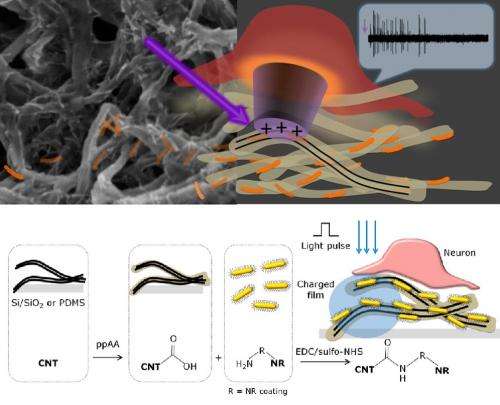November 11, 2014 feature
Carbon nanotube film restores light sensitivity to blind retinas

(Phys.org) —Light striking the retina in the back of the eye is the first major step in the vision process. But when the photoreceptors in the retina degenerate, as occurs in macular degeneration, the retina no longer responds to light, and the person loses some or all of their sight. However, if the retina can be made sensitive to light with the help of some type of optoelectronic implant, then vision may be restored.
The development of artificial retinas still faces many challenges: the implants should provide long-term light sensitivity, should have high spatial resolution, should not contain wires, and should be made of materials that are biocompatible and mechanically flexible. Candidate materials include conducting polymers and quantum dot films, with each having its own advantages and disadvantages in these areas.
Another approach to restoring light sensitivity involves optogenetics, in which light-sensitive proteins (bacterial opsins) are introduced into neurons in the retina. However, this method still requires an electrode to assist in light-induced stimulation of these neurons.
In a new paper published in Nano Letters, researchers at Tel Aviv University, The Hebrew University of Jerusalem, and Newcastle University have found that a film containing carbon nanotubes and nanorods is particularly effective for wire-free retinal photostimulation.
"The greatest significance of our work is in demonstrating how new materials (quantum rods combined with carbon nanotubes) can yield a new system suitable for efficient stimulation of a neuronal system," coauthor Yael Hanein, Professor at Tel Aviv University, told Phys.org.
The researchers showed that, when the film is attached to a chick retina at 14 days of development (at a time when the retinas are not yet light-sensitive, and so completely blind), the retinas produce a photogenerated current—a neuronal signal that can then be interpreted by the brain.
In the new film structure, the nanorods are interspersed throughout a 3D porous carbon nanotube matrix, and the resulting film is then patterned onto a flexible substrate for implantation. The researchers explain that the 3D structure of the new film provides several advantages, which include high light absorbance, strong binding to neurons, and efficient charge transfer. While other candidate materials for artificial retinas, such as silicon, are rigid, nontransparent, and require an external power source, the new material does not have these problems.
With these advantages, the new films look very promising for use in future artificial retina applications. The researchers also expect that the films could be improved even more with further research.
"At the present, we study the new implants in vivo, attempting to demonstrate their performances over long-term implantation," Hanein said. "We teamed up with a retina surgeon to develop an implantation and testing procedures compatible with conventional surgical practices towards attempting human trials in the future."
More information: Lilach Bareket, et al. "Semiconductor Nanorod-Carbon Nanotube Biomimetic Films for Wire-Free Photostimulation of Blind Retinas." Nano Letters. DOI: 10.1021/nl5034304
Journal information: Nano Letters
© 2014 Phys.org





















